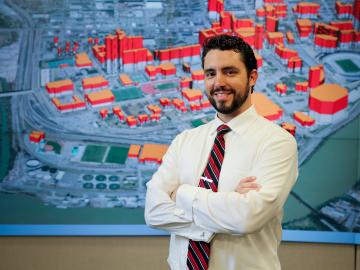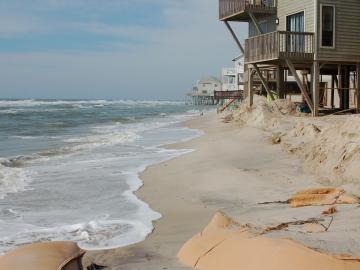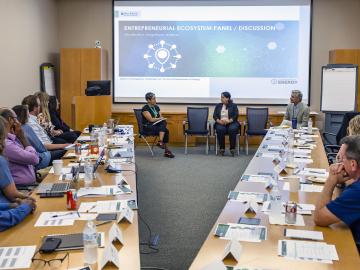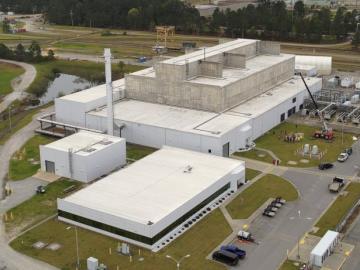
Filter News
Area of Research
- Advanced Manufacturing (1)
- Biology and Environment (37)
- Biology and Soft Matter (1)
- Computational Biology (1)
- Computer Science (1)
- Electricity and Smart Grid (1)
- Energy Science (31)
- Functional Materials for Energy (1)
- Fusion and Fission (9)
- Isotopes (20)
- Materials (31)
- Materials for Computing (3)
- National Security (18)
- Neutron Science (10)
- Nuclear Science and Technology (8)
- Supercomputing (37)
News Type
News Topics
- (-) Advanced Reactors (18)
- (-) Artificial Intelligence (87)
- (-) Chemical Sciences (47)
- (-) Composites (16)
- (-) Cybersecurity (20)
- (-) Fossil Energy (6)
- (-) Isotopes (43)
- (-) Space Exploration (14)
- 3-D Printing/Advanced Manufacturing (77)
- Big Data (54)
- Bioenergy (76)
- Biology (88)
- Biomedical (48)
- Biotechnology (26)
- Buildings (42)
- Clean Water (17)
- Computer Science (133)
- Coronavirus (24)
- Critical Materials (7)
- Education (2)
- Emergency (3)
- Energy Storage (52)
- Environment (138)
- Exascale Computing (53)
- Frontier (48)
- Fusion (49)
- Grid (37)
- High-Performance Computing (93)
- Hydropower (6)
- Irradiation (1)
- ITER (5)
- Machine Learning (42)
- Materials (84)
- Materials Science (84)
- Mathematics (9)
- Mercury (7)
- Microelectronics (3)
- Microscopy (35)
- Molten Salt (3)
- Nanotechnology (33)
- National Security (70)
- Neutron Science (98)
- Nuclear Energy (84)
- Partnerships (42)
- Physics (45)
- Polymers (17)
- Quantum Computing (37)
- Quantum Science (53)
- Security (21)
- Simulation (48)
- Software (1)
- Statistics (2)
- Summit (42)
- Transportation (46)
Media Contacts

Nuclear physicists at the Department of Energy’s Oak Ridge National Laboratory recently used Frontier, the world’s most powerful supercomputer, to calculate the magnetic properties of calcium-48’s atomic nucleus.

ORNL’s Joshua New was named the 2024 Researcher of the Year by R&D World magazine as part of its R&D 100 Professional Award winners.

Jeremiah Sewell leads a team at ORNL, working on xenon-129 production for lung imaging. Reflecting on his career, Sewell views each opportunity as a "door" he steps through, leveraging over 25 years of experience in nuclear power and centrifuge operations to advance the facility’s mission.

Debjani Singh, a senior scientist at ORNL, leads the HydroSource project, which enhances hydropower research by making water data more accessible and useful. With a background in water resources, data science, and earth science, Singh applies innovative tools like AI to advance research. Her career, shaped by her early exposure to science in India, focuses on bridging research with practical applications.

A study found that beaches with manmade fortifications recover more slowly from hurricanes than natural beaches, losing more sand and vegetation. The researchers used satellite images and light detection and ranging data, or LIDAR, to measure elevation changes and vegetation coverage. Changes in elevation showed how much sand was depleted during the storm and how much sand returned throughout the following year.

Benjamin Manard, an analytical chemist in the Chemical Sciences Division of the Department of Energy’s Oak Ridge National Laboratory, will receive the 2024 Lester W. Strock Award from the Society of Applied Spectroscopy.

Five researchers at the Department of Energy’s Oak Ridge National Laboratory recently completed an eight-week pilot commercialization coaching program as part of Safari, a program funded by DOE’s Office of Technology Transitions, or OTT, Practices to Accelerate the Commercialization of Technologies, or PACT.

Two ORNL teams recently completed Cohort 18 of Energy I-Corps, an immersive two-month training program where the scientists define their technology’s value propositions, conduct stakeholder discovery interviews and develop viable market pathways.

A team of federal contractor and national laboratory engineers and scientists from the U.S. Department of Energy Office of Environmental Management has been nationally distinguished as “Heroes of Chemistry” for making the world better through their effort, ingenuity, creativity and perseverance.

Researchers at the Department of Energy’s Oak Ridge National Laboratory and partner institutions have launched a project to develop an innovative suite of tools that will employ machine learning algorithms for more effective cybersecurity analysis of the U.S. power grid.


